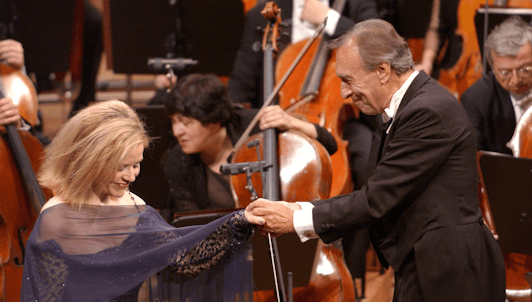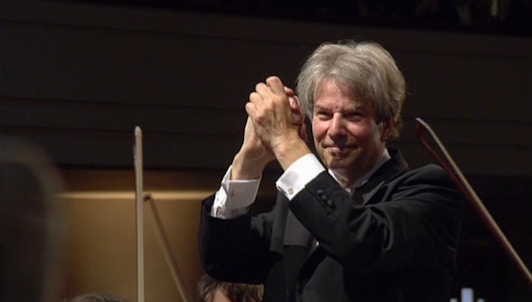It was in 1970 that Mickael TilsonThomas made his debut with the London Symphony Orchestra, the same year ad his appointment as associate conductor of the Boston Symphony, after he had found himself making an unexpected New York debut with the previous October, stepping in mid-concert to replace William Steinberg. At the age of only twenty-five, and having already embarked on his prolific recording career with, characteristically, an album of Ives and Ruggles, Tilson Thomas personified the musical wunderkind. Regular television appearances soon followed, starting with the CBS Young People's Concerts in the early 1970s, and they have gone on to form an important part of his musical work.
Comparisons with Bernstein are tempting, not only in terms of the two conductors' meteoric rise to fame, but also in their urge to communicate on music, intelligently and excitingly, to the widest possible audience. Today, Tilson Thomas's Keeping Score programmes with his San Francisco Symphony orchestra continue in the same spirit as the films he made for the BBC during his tenue as Principal Conductor of the LSO in the 1980s and '90s. Two years before he took up his London appointment in 1988, he scripted and presented the fascinating, detailed television essay on Strauss's Till Eulenspiegel that is crowned by the performance preserved here. This studio performance was followed up by a more ambitious programme on Ein Heldenleben, filmed live in front of an audience in the orchestra's home at London's Barbican Centre in 1994, featuring the conductor's own engaging and illuminating introduction.
Tilson Thomas's BBC music programmes with the LSO did not form part of a regular broadcast series, and the subjects they covered ranged widely, from Gershwin to Rimsky-Korsakov, and Beethoven to Sibelius. When it came to the
Heldenleben
programme, whatever equivocal noises the composer may have made about the content of the music, it was the autobiographical element that was picked up on. Similarly, Tilson Thomas's Till Eulenspiegelhad elided the 'rogue' of the work subtitle with the composer himself, and placed Strauss at the heart of his own music – the film was called Richard Strauss's Many Pranks. The director of the later film, Barrie Gavin, had a clear vision for the piece: 'I had considered different ways of doing Heldenleben, and I thought that instead of using musty old photos, why not insert the visual part into the music, and make it mean something. It is a kind of secret autobiography, not without a certain humour and irony, and it needed a designed component that would really work.' Graphic artist Pat Gavin (no relation to the director), best known for his title sequence for the long-running South Bank Show, came up with the images of the Strausses, in their youth, and in the autumnal glow of old age (their house in Garmisch is clearly shown), adding animations to accompany the most apocalyptic sounds the composer and his massive orchestra can conjure up, and throwing in a kitchen sinkfor good measure.
In both works, it is striking that Strauss was at first reluctant to pin down his intentions in words. He left it to friends to specify the six sections of Ein Heldenleben that Pat Gavin's illustrations mark out in the film, and the detailed descriptions of the narrative that drives Till Eulenspiegel and that appear in the film here were a later concession. The piece itself emerged from the failure of Strauss's opera Guntram, first in Weimar in 1894, and then resoundingly in Munich the following year, and both orchestral works portray a central figure faced by philistines and carping critics. Strauss originally intended Till Eulenspiegel, the mocking joker of medieval German legend, to be the protagonist of a one-act opera, but this plan was abandoned in the summer of 1894, in favour of story-telling in the form with which Strauss had so spectacularly made his name, the orchestral tone poem.
The piece may claim to be a 'rondo', with the musical motifs for the roguish Till himself the principal theme, but there is an element of orchestral variations as well – the form that would later serve for the portrayal of Don Quixote- that prompts all sorts of instrumental wizardry from Strauss to tell the story. On the question of narrative, Tilson Thomas relates a revealing anecdote told by the cellist Gregor Piatigorsky, who, when rehearsing Don Quixote under Strauss's baton, had asked the composer for some pointers. Strauss's reply was that the cellist 'sang' the music, when it should be 'spoken', a comment that hints at the opera-composer who was soon to emerge, able to create the spontaneous, smooth-flowing musical dialogue that defines his stage works.
Kenneth Chalmers
© ICA


